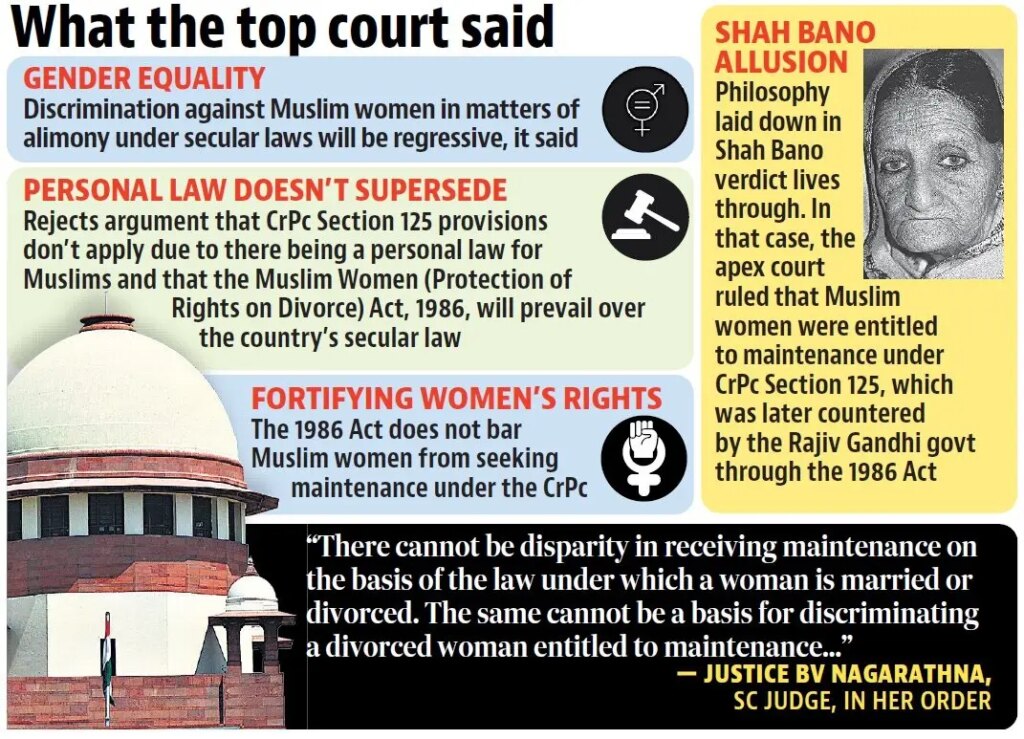By Rohin Bhatt
A shift to the far right, democratic decay, and a crisis of constitutional beliefs have created a near perfect storm for backlash against rights of minorities, whether they be marginalised along caste, class, gender or sexuality. For long, the language of the law has been that of men. For example, the standard of reasonableness is that of the man on a Clapham omnibus. In that way, as Catharine MacKinon reminds us, the testifying of a witness is so brutal that it resembles ‘re-raping’ the victim. Much has already been written about the backlash in courts, against rights of transgender persons and women, and much more will be written on.
Something to focus on is documenting how this backlash comes out in courts, in pleadings, and in oral arguments.
There are two rounds of arguments which warrant discussion, the first, the argument of the Union of India filed through an affidavit dated October 3, 2024 in the Supreme Court, and second, the argument of the Men’s Rights groups, in RIT Foundation case before the Delhi High Court, and reiterated before the Supreme Court. The arguments, in both cases, share similar intensities of enthusiasm, and are identical in content. Yet, on closer inspection, they are simply bluster, incapable of standing even the most perfunctory of legal scrutiny.
But I wish to draw a distinction between the two, because the stance which is adopted by the Union is impermissible because of the obligations in Article 15(1) and Article 15(3). A circumlocution of these two provisions is not merely an obfuscation but completely constitutionally impermissible. On the other hand are the arguments of men’s rights groups, who have used this litigation as a reason to fuel anxieties and moral panic. I will limit my analysis in this piece to merely the legal arguments advanced by the Union in Hrishikesh Sahoo because the arguments of the men’s rights groups warrant a larger conversation around dog whistling against the rights of women through Instagram reels, a supposed boycott of marriage and twitter storms with #MarriageStrike and their own anthropological and sociological analysis. One must draw attention to the fact that in both, then old and the new penal laws, the marital rape exception has remained intact, and thus, while the same may not be a legislative backlash, per se, it represents a stasis in terms of where the needle remains on the progress of the Indian women’s movement.
The Union’s affidavit, first talks about what marriage is, and for that it looks at the following non exhaustive list of cases which are mentioned in footnotes to the affidavit: Nachimson v Nachimson [1930] P 217, CA; Hyde v Hyde and Woodmansee (1866) LR 1 P & D 130; Re Bethell, Bethell v Hildyard (1888) 38 ChD 220; Sowa v Sowa [1961] P 70, {1961] 1 All ER 687, CA. Nachimson v Nachimson [1930] P 217, CA; Cheni (otherwise Rodriguez) v Cheni [1965] P 85, [1962] 3 All ER 873. Kenward v Kenward (1951] P 124, [1950] 2 All ER 297, CA. Dalrymple v Dalrymple (1811) 2 Hag Con 54.
The first question that must be posed to the law officers is that given marital law, and fundamental rights that have evolved in India, can we use these cases today to determine the status of women in a marriage?
These cases predate the R v. R case, where the doctrine of coverture, or the idea that a woman has the chattel in marriage was held to be good law in England. When the Constitution of India came into force, women across class, caste, gender, sexuality and religion were placed on the same footing as men. Despite the Union’s explicitly articulated pursuit of decolonisation, the government has not only retained, but vehemently defended the idea of coverture.
Paragraph 30 of the same affidavit reads as follows, “It is submitted that the sexual aspect is but one of the many facets of the relationship between husband and wife, on which the bedrock of their marriage rests. Care, consideration, and an understanding of one other’s likes and dislikes, hopes and aspirations, are fundamental to the sustenance of a marriage that is to abide. Given the nature of the marital institution in our socio-legal milieu, if the legislature is of the view that, for preservation of the marital institution, the impugned Exception should be retained, it is submitted that it would not be appropriate for this Hon’ble Court to strike down the Exception.”
Given the fact that there is an admission of care, consideration and understanding being ‘fundamental to the substance of a marriage’, the second part of the paragraph does not logically follow from the first.
Paragraph 53 of the same affidavit reads as follows: “Considering the nature of Section 375, its legislative strength and its strong punitive attributes, the Legislature sought to exclude the application of such a drastic provision to the context of marriage while providing a suitable provision for the context of marriage. In essence, Section 375, and its legislative universe surrounding it, is designed in a manner that it envisages a relationship [or lack thereof] other than one of marriage between a man and a woman.”
To my mind, this is an admission that the legislature views the violation of bodily autonomy of the woman as a crime of the magnitude that deserves to be responded with through the strongest punishment. Secondly, as Indira Jaising argued, a mere reading of Exception 2 shows that it is only sexual intercourse and sexual acts between a husband and a wife which is exempted from Section 375 of the Indian Penal Code. Nowhere does the Exception condone sexual abuse by a man of his wife. Paragraph 53, too, does little to advance the argument.
The further interesting aspect of this affidavit are the Annexures A and B. Annexure A is a letter dated February 10, 2022 by Joint Secretary to the Ministry of Home Affairs asking the views of the States on criminalization of marital rape. The second paragraph of this letter reads,
“The Government is committed to protect the liberty, dignity and rights of every woman. However, the question involved in the petition is not merely a question concerning constitutional validity of the above said statutory provision, as the subject matter has and will have far reaching socio-legal implications in the country. The Department Related Standing committee on Home Affairs in its 1678′ Report in para 5.9.1 observed that in case marital rape is brought under law, the entire family system will be under great stress and it has potential of destroying the institution of marriage.”
To my mind, if the government is indeed committed to these things, then the position that it takes is almost indefensible. What takes the cake is the responses to these questions which I reproduce below.
Note here that most states which defend the marital rape exception are those that are ruled by the Bharatiya Janata Party. I do not say this to make a political point, for after all, the Rajasthan government under the Indian National Congress opposed the marriage equality petition, but to make a point that the exercise itself, and the reliance upon it to tell the Court to not adjudicate on fundamental rights, surely seems farcical. Consent or views of a state government while the Court is judicially reviewing a statute are immaterial and the Court ought to be guided solely, by constitutional morality. This is a bogey that ought not to be dealt with but merely dismissed—for if the courts start deciding on rights of marginalized sections based on the will of the tyranny then we might as well consign Part III of the Constitution to the dustbin.
There is much talk raised about alternative remedies and other provisions of the penal law which may be used. Consider, however, the case of Gorakhnath Sharma v. State of Chhattisgarh (2024) where a man was acquitted by the Chhattisgarh High Court after his wife was sexually assaulted and murdered by him. Even though violence and abuse was writ large in the facts and the wife was dead, the Court acquitted the husband of a charge under Section 304 merely with one paragraph. It reads:
“So far as Section 304 IPC is concerned, learned trial Court has not recorded any finding how the offence under Section 304 of the IPC is attracted to the present facts of the case and proved by the prosecution, still it has convicted the appellant under Section 304 IPC which is nothing but perversity and patent illegality which is deserve [sic] to be interfered by this Court while exercising Appellate Court power under Section 386 of the CrPC as the finding of conviction is based on no evidence or on perverse findings”
The only question that needs to be asked is this: Was the dead body of the woman, who was subjected to such brutality that her anus was perforated, not enough evidence to convict the husband?
Pratixa Baxi pithily argues that, “the emphasis on everyday processes of law providing accounts of subjection and resistance is important as it allows us to re-think the categories that are normalised by the doctrinal picture of law.”
Is it not the time to rethink the normalization of marital rape 75 years since Constitution’s adoption and over seven months since a new criminal regime, supposedly focused on women and justice, kicked into effect? The conversations around rape trials needs to shift from discussions of consent, and the framing of a perfect victim (which a wife is not). Instead, discussions must focus more clearly on gender-based violence, and its permissibility. So long as this shift does not occur, we can do little to effectively resist and counter the backlash in courts, on social media, and in our legal system. (IPA Service)




 Uneven Development Has Led To North-South Tensions
Uneven Development Has Led To North-South Tensions 